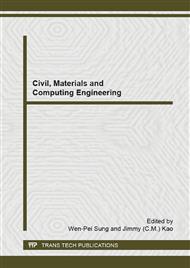[1]
Srinivasan, Mandayam A., and Cagatay Basdogan. Haptics in virtual environments: Taxonomy, research status, and challenges., Computers & Graphics 21. 4 (1997): 393-404.
DOI: 10.1016/s0097-8493(97)00030-7
Google Scholar
[2]
Wikipedia http: /en. wikipedia. org.
Google Scholar
[3]
Basdogan, Cagatay, et al. Haptics in minimally invasive surgical simulation and training., Computer Graphics and Applications, IEEE 24. 2 (2004): 56-64.
DOI: 10.1109/mcg.2004.1274062
Google Scholar
[4]
Wood, John, et al. The design and evaluation of a computer game for the blind in the GRAB haptic audio virtual environment., Proceedings of Eurohpatics(2003).
Google Scholar
[5]
Srinivasan, Mandayam A., and Cagatay Basdogan. Haptics in virtual environments: Taxonomy, research status, and challenges., Computers & Graphics 21. 4 (1997): 393-404.
DOI: 10.1016/s0097-8493(97)00030-7
Google Scholar
[6]
Ruffaldi, Emanuele, et al. A haptic toolkit for the development of immersive and web-enabled games., Proceedings of the ACM symposium on Virtual reality software and technology. ACM, (2006).
DOI: 10.1145/1180495.1180559
Google Scholar
[7]
Seo, Yoonho, Dae-Young Kim, and Suk-Hwan Suh. Development of web-based CAM system., The International Journal of Advanced Manufacturing Technology 28. 1-2 (2006): 101-108.
Google Scholar
[8]
SenseGraphics, A.B. H3D API., (2011).
Google Scholar
[9]
Alamri, Atif, Mohamad Eid, and Abdulmotaleb El Saddik. Towards a standard modeling of haptic software system., Haptic Audio Visual Environments and their Applications, 2006. HAVE 2006. IEEE International Workshop on. IEEE, (2006).
DOI: 10.1109/have.2006.283552
Google Scholar
[10]
NPAPI https: /developer. chrome. com/extensions/npapi.
Google Scholar
[11]
Martin, Steven, and Nick Hillier. Characterisation of the Novint Falcon haptic device for application as a robot manipulator., Australasian Conference on Robotics and Automation (ACRA). (2009).
Google Scholar
[12]
Massie, Thomas H., and J. Kenneth Salisbury. The phantom haptic interface: A device for probing virtual objects., Proceedings of the ASME winter annual meeting, symposium on haptic interfaces for virtual environment and teleoperator systems. Vol. 55. No. 1. (1994).
DOI: 10.1109/haptic.2002.998933
Google Scholar
[13]
Asai, K., N. Takasa, and M. Sato. 2D force feedback for haptic interaction with SPIDAR-mouse by mapping 3D surface to plane in molecular docking., Demonstrations at IEEE World Haptics Conference. (2013).
DOI: 10.1109/smc.2013.100
Google Scholar
[14]
Sato Makoto Lab. http: /sklab-www. pi. titech. ac. jp.
Google Scholar
[15]
Kim, Seahak, et al. Tension based 7-dof force feedback device: Spidar-g., Virtual Reality, 2002. Proceedings. IEEE. IEEE, (2002).
DOI: 10.1109/vr.2002.996540
Google Scholar
[16]
Maruyama, Naoki, et al. Precision and Intelligence Laboratory Tokyo Institute of Technology., Artificial Reality and Telexistence (ICAT), 2013 23rd International Conference on. IEEE, (2013).
DOI: 10.1109/icat32640.2013
Google Scholar
[17]
HTML5 http: /www. w3. org/TR/html5.
Google Scholar
[18]
Khronos. org https: /www. khronos. org.
Google Scholar
[19]
Kokkonis, G., et al. Evaluating transport and application layer protocols for haptic applications., Haptic Audio Visual Environments and Games (HAVE), 2012 IEEE International Workshop on. IEEE, (2012).
DOI: 10.1109/have.2012.6374436
Google Scholar
[20]
Karunanidhi, Upparapalli. Navigation system using position network for map matching., U.S. Patent No. 6, 108, 603. 22 Aug. (2000).
Google Scholar


